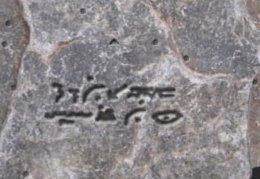http://en.wikipedia.org/wiki/Meroitic_script
Meroitic script
From Wikipedia, the free encyclopedia
Jump to: navigation, search
Meroitic
Type: Alphabet
Languages: Meroitic and possibly Old Nubian
Time period: ~200 BC to 600 AD
Parent writing systems: Egyptian hieroglyphs
Demotic script
Meroitic
ISO 15924 code: Mero
Note: This page may contain IPA phonetic symbols in Unicode. See IPA
chart for English for an English-based pronunciation key.
History of the Alphabet
Meroitic 3rd c. BC
Complete genealogy
The Meroitic script is an alphabet of Egyptian hieroglyphic and Demotic
origin that was used to write the Meroitic language of the Kingdom of
Meroë by at least c. 200 BC — and possibly also the Nubian language of
the successor Nubian kingdoms, that was later written in a Greek uncial
alphabet which adopted three of the old Meroitic glyphs.
Being primarily alphabetic, the Meroitic script worked in quite a
different way than Egyptian hieroglyphs. Some scholars, e.g. Haarmann,
believe that the Greek alphabet played a role in its development,
primarily because Meroitic had letters for vowels; although in other
respects it did not function much like Greek.
The Meroitic script was essentially alphabetic, but with a default vowel
/a/ assumed unless another vowel was written. A consonant by itself was
indicated by the vowel /e/ (schwa) following the symbol. That is, the
two letters me represented both the syllable /me/ and the consonant /m/
by itself, while the syllable ma was written with one letter, and mi
with two. Some other syllables had special glyphs. In this sense, it is
properly a 'semi-syllabic' script, only vaguely reminiscent of the
Indian abugida alphabets that arose around the same time. Several
syllable-final consonants, such as /n/ and /s/, were often omitted.
There were 23 symbols in total. These included four vowels:
* a (at the beginning of a word only; otherwise /a/ was assumed), e (or
schwa), i, o (or u);
fourteen or so consonants, with an assumed vowel /a/ unless another
vowel was indicated:
* y(a), w(a), b(a), p(a), m(a), n(a), r(a), l(a), ch(a) (perhaps
palatal, as in German ich, or uvular, like Dutch dag), kh(a) (velar, as
in German Bach), k(a), q(a), s(a) or sh(a), d(a);
and several syllables:
* ne or ny(a), se or s(a), te, to, t(a) or ti.
There some is dispute over whether se represented a syllable or a
consonant /s/, distinct from s as /š/; likewise whether ne was a
syllable or a consonant /ñ/; and whether t might have been a syllabic
ti. It has been suggested that the use of syllables instead of
alphabetic letters for some sounds may have been due to the needs of
representing Meroitic dialectical variation within a single unified script.
There were two graphic forms of the Meroitic alphabet: a monumental
lapidary form taken from Egyptian hieroglyphs, and a cursive form
derived from demotic. The majority of texts are cursive. Unlike Egyptian
writing, there was a simple one-to-one correspondence between the two
forms of Meroitic, except that in the cursive form, a consonant is
joined in a ligature to a following i.
The direction of writing was from right to left, top to bottom
(cursive); or top to bottom in columns going right to left (hieroglyphic
form). The monumental signs faced toward the beginning of a text, as did
their Egyptian hieroglyphic sources.
There was also a sign of three horizontal or vertical dots used to
divide words or phrases; this was the only punctuation used.
If it was indeed used by the Nubian kingdoms, the Meroitic script would
have been replaced by the Coptic alphabet with the introduction of
Christianity to Nubia in the sixth century CE.
The writing was deciphered in 1909 by Francis Llewellyn Griffith, a
British Egyptologist. However, the language itself is still not fully
understood
 ...
...